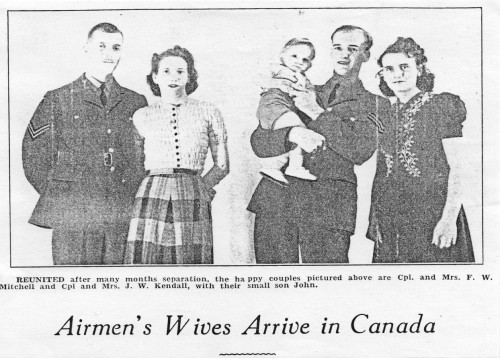The first news that No. 1 Relief Landing Ground, Gananoque, was to become a training station is found in the C/O’s diary. On June 22, he noted that aircraft serviceability had reached a low ebb. They had seventeen dual and nine solo aircraft with which to maintain eight flights. Also, in the midst of this thirteen young men arrived for training from Singapore via Vancouver and they would join the others just arriving in Halifax for No. 24 Course. The C/O noted that training was hampered because the runways had proved to be too narrow and construction began on widening them. As a solution to the need for more extensive training, the decision was made to erect buildings, which would accommodate 100 men and up to twenty planes, at the relief landing ground near Gananoque.
This brought life to the town whose young men had begun enlisting as soon as war was declared. Now the streets would see air force blue on a regular basis and the British accents from every part of the United Kingdom could be heard. The R.A.F. joked that the gates (the town’s eastern and western gates) were closed at 9 p.m., and it really seemed true, except for the theatre and cafes. Only on Saturday nights was there any activity as the stores remained open late to accommodate the farmers in the area. Till midnight, both sides of the main street (one block long) would be filled with lights, music and “excitement”.
LAC R. E. Fellows – July 15, 1941
In a crash involving a civilian, LAC Robert Edward Fellows, age 22, was instantly killed when his Fairey Battle crashed two miles north of Belleville and Mr. William Grundy, on whose land the plane crashed, was seriously injured and taken to Belleville General Hospital suffering from arm and leg injuries. “I thought I was done for,” said the farmer. He described how the low-flying plane dived straight at him as he was standing near the chicken coop unhitching a team of horses. The aircraft swooped low over a grove of trees, he said, and then the engine seemed to stall and the machine fell crashing into the coop.
LAC Fellows was the son of John and Maggie Fellows, of Cradley Heath, Staffordshire. He is buried in the military plot at Cataraqui Cemetery.

Things cheered up as men welcomed family to the peace of the land of no air raids, blackouts, or near-empty shops with long queues. August 16, 1941, was the happy day for married airmen who had applied to have their families join them when the first group arrived in Kingston, with more on their way. The cost of the sea journey was 21 pounds for adults; 10 pounds 10 shillings for children 5 to 12 years; 5 pounds 5 shillings for those between 1 year to under 5 years. Rail fare to their destination in Canada would not exceed 5 pounds. [A pound in those days was equal to approximately $4.50.] The women received notification as to the time and place of embarkation with no definite guarantee that a passage would be available. They received very little warning and had to be ready to move on an instant’s notice. They were allowed four cwt in baggage which could have no other markings than their home and code letters provided by the Royal Air Force.
They were committed to secrecy: “In the interest of your own safety and of the safety of the ship and all on board you should treat the information given in this letter as strictly confidential. You are forbidden under existing regulations to communicate by letter or otherwise any information regarding the ship’s movements or destination. The information contained herein is given to you in confidence for your own information only and must not be divulged to any third party except as laid down herein.”
Next Chapter: 14. Desperately Needed Harvards Arrive
Previous Chapter: 12. First Canadian F.A.A. Pilots Graduate In Canada